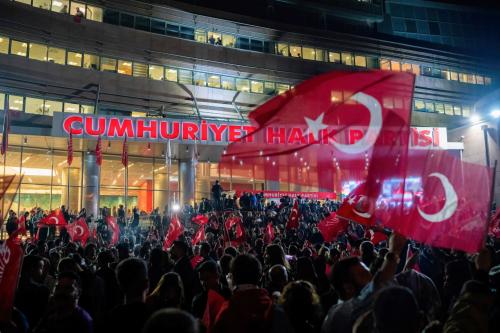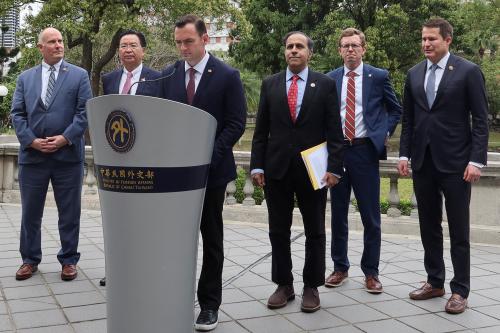Ukrainians went to the polls on Sunday to elect a new Rada (parliament). The election revalidates the Rada’s democratic legitimacy and should result in a parliament that better reflects the national mood, which has changed significantly since the last election in 2012.
In a country with a simmering separatist conflict and a host of domestic problems, the election produced good news. First, the Organization for Security and Cooperation in Europe (OSCE) and other observers gave the election process high democratic marks. Second, of the parties set to enter the new Rada, those favoring a pro-reform, pro-European Union course won a large majority of the votes.
President Poroshenko’s party appears to have won the most seats, though it will need to put together a coalition to organize a stable majority in the Rada. The coalition should be formed quickly so that the Rada can approve a new prime minister and cabinet, and then tackle the long list of critical challenges facing Ukraine. Expectations for genuine progress on domestic reforms, both on the part of Ukrainians and Kyiv’s supporters in the West, will be high.
Ukrainians Go to the Polls
For the second time in five months, Ukrainians went to the polls in a national election. This time they chose a new Rada (on May 25, they elected Petro Poroshenko as president).
The Central Electoral Commission put turnout at 52.4 percent. By all appearances, the election proceeded normally, with just minor incidents reported. The OSCE observer mission said the election process met Ukraine’s democratic commitments and offered the electorate a genuine choice. Other observers likewise gave the election high marks. That’s good news for democracy in Ukraine.
Voters had two ballots to cast. First, a party-list vote determines the distribution of 225 of the Rada’s 450 seats. A party has to secure at least 5 percent of the votes cast in order to win party-list seats (the votes that go to parties that fail to cross the 5 percent threshold will be redistributed among parties that did).
Second, each voter also votes for a Rada deputy to represent his/her constituency. Nominally, Ukraine is divided into 225 constituencies. In Sunday’s election, however, 27 constituency seats went unfilled—12 in Russian-occupied Crimea and 15 in parts of Donetsk and Luhansk that are controlled by pro-Russian separatists. Candidates for constituency seats can run with party affiliations or as independents.
The Election Results
Exit polling is more art than science, but in Ukraine it has become a well-developed art (for example, exit polls very closely predicted the official results of the May 25 presidential election). According to Sunday’s exit polls:
• The Party of Poroshenko (the president’s party) came in first, winning 23 percent of the party-list vote, down from pre-election projections that it would win 30 percent.
• The People’s Front, led by Prime Minister Yatseniuk, won 21 percent of the party-list vote, considerably out-performing pre-election forecasts.
• The Self-Reliance Party led by reformist Lviv Mayor Sadovy won 13 percent, also doing better than expected.
• The Opposition Bloc, the successor to former president Yanukovych’s Regions Party, won 8 percent of the vote to come in fourth.
• The Radical Party, which many analysts had projected to win the second largest number of party-list votes, in fact came in fifth with 6 percent.
• Rounding out the list, the Svoboda (Freedom) Party placed sixth at 6 percent, while the Batkivshchyna (Fatherland) Party of former Prime Minister Tymoshenko squeaked across the 5 percent threshold.
With about half of the party-list ballots tabulated, the Central Election Commission’s numbers generally matched those reported by the exit polls, with two exceptions. The People’s Front had a very slight lead for first place over the Party of Poroshenko, and the Svoboda Party had not (yet) cleared the 5 percent threshold.
One notable party did not reach the 5 percent threshold. For the first time since Ukraine regained independence in 1991, the Communist Party will hold no party-list seats.
The Central Electoral Commission is also counting individual constituency seats, where it appears that the Party of Poroshenko will do well, making it the largest party in the parliament. It may take some time to sort out final affiliations. One problem in the past has been the practice of bribing constituency deputies to align with particular parties. Many proposed doing away with the constituency vote and instead having all 450 seats allotted by the party-list vote, but that would have required amending the constitution, and there was no time before this election.
The election will bring many newcomers to the Rada’s ranks, including reform activists who decided that they must work from within the system to effect dramatic change. The election also returns some members of the old guard who were affiliated with disgraced former president Yanukovych; their votes and views will come under close scrutiny.
On the whole, the election showed the practical, moderate side of the Ukrainian electorate. The Poroshenko, People’s Front, Self-Reliance and Batkivshchyna parties all have pro-reform, pro-European Union platforms. There is a coalition to be had in the new parliament that can command a significant majority—perhaps even 300 votes, which would be sufficient to amend the constitution. (Among the reforms proposed by Mr. Poroshenko, decentralization of certain authorities from Kyiv to the regions will require changing the constitution.)
Of the parties that crossed 5 percent threshold, only one—the Opposition Bloc—may be sympathetic to Russian policy preferences. Moscow has itself to blame. First, Russia’s seizure of Crimea and support for the separatists in Donetsk and Luhansk fueled the development of a stronger Ukrainian national identity, one that increasingly looks to Europe as its model. Second, the voters in Crimea and separatist-controlled Donetsk and Luhansk traditionally have been more pro-Russian than the rest of Ukraine, but they could not vote.
A Daunting Agenda… and a Need to Get Moving
The immediate task for the Rada is formation of a coalition and appointment of a prime minister and cabinet. Both Mr. Poroshenko and Mr. Yatseniuk have indicated that they want to move quickly on this. Some had suggested that Mr. Poroshenko might seek to replace Mr. Yatseniuk with Deputy Prime Minister Groysman, but the strong showing of the People’s Front will strengthen Mr. Yatseniuk’s hand.
Once the coalition, prime minister and new cabinet are in place, they need to work with Mr. Poroshenko to tackle a daunting agenda of needed political and economic reforms, anti-corruption measures, overhaul of the judicial system and urgent changes to the energy sector. The distraction of the conflict in eastern Ukraine has absorbed most of Kyiv’s attention the past six months. Mr. Poroshenko also said that Ukraine needed a new parliament before it could undertake serious reforms.
The president now has his new Rada. It is time to move. Urgent reforms are needed in the economic and energy sectors if Ukraine is to avoid becoming—some would say remaining—an economic basket case.
Public expectations for change will be high, now that the election is done. Frustration was growing before the election with the slow pace of reform. If there is no tangible action soon, public support for Mr. Poroshenko may begin to erode. Progress on fighting corruption will be a particular metric by which the president and Rada’s performance is judged.
Expectations in the West regarding progress on reforms likewise will be high. Kyiv needs to deliver to maintain the support of the International Monetary Fund program and to make the case—as it seems that it will have to—for additional Western financial assistance. Securing U.S. and European agreement to provide more help will be difficult enough; it will prove impossible if Kyiv delays much needed reforms.
A strong Rada coalition that works with Mr. Poroshenko to advance a reform agenda will send a useful signal to Russia. Moscow cannot be pleased by the election results and the number of votes that went to pro-European Union parties. If the Rada fails to produce a stable coalition, however, the Kremlin will be tempted to engage in political mischief-making in Kyiv with the goal of making it harder for Ukraine to pursue needed policies.
Much is riding on the performance of the new Rada and how it works with Mr. Poroshenko. Ukraine has little time to waste.


Commentary
Ukraine’s Parliamentary Election: What Happened? What’s Next?
October 27, 2014